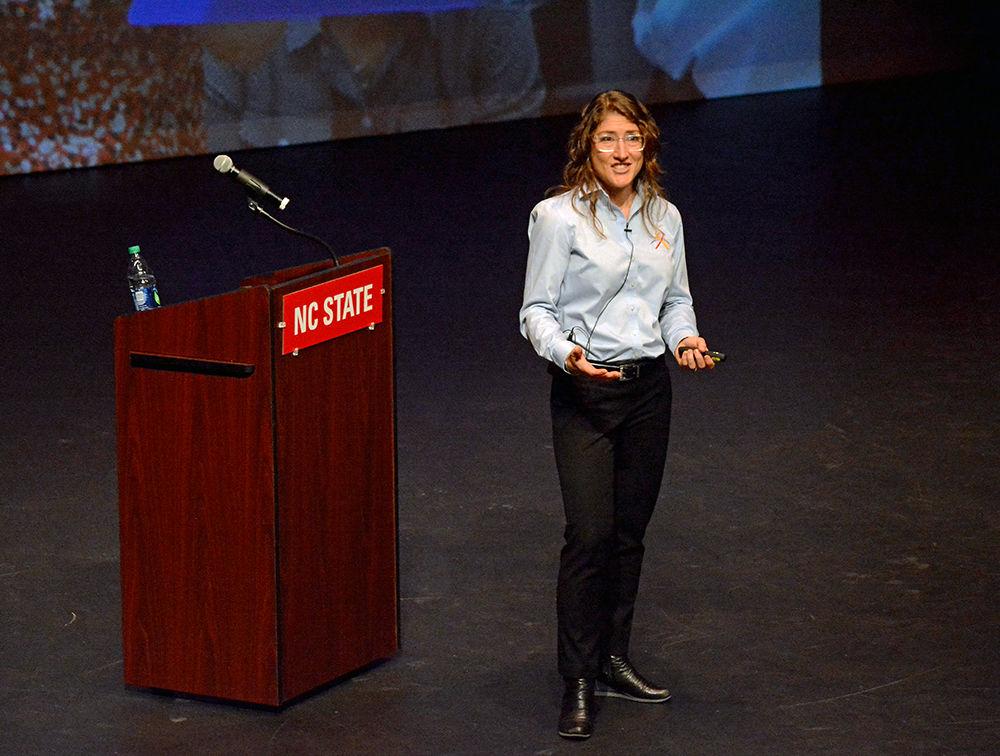Renowned NC State alumna and NASA astronaut Christina Koch concluded the first day of Red and White Week, speaking about her life experience and encouraging students in Talley Student Union Monday evening.
From her time earning her Bachelor of Science degrees in physics and electrical engineering to becoming a NASA astronaut, Koch described her career and the life choices that affected her.
“I love getting to interact with students and spread the word about what’s going on at NASA,” Koch said. “I give tours all of the time at NASA.”
Although she received encouragement from her parents, professors and peers along her career, Koch described a lifelong passion for becoming an astronaut.
“I grew up in Jacksonville, North Carolina,” Koch said. “As a girl, I always wanted to be an astronaut … I don’t even remember a time when I didn’t want to be an astronaut. I was really intrigued with anything that had to do with exploration, anything that had to do with exploration of the frontiers.”
Koch’s career opportunities varied widely: she traveled around the world as a researcher and technician. Her two jobs were at NASA, working as an electrical engineer in scientific instrument design. Although she took a year away as a cryogenics technician in Antarctica, she returned to NASA to participate in instrument design for the Jupiter satellite, Juno.
“When I left my perfectly good job at NASA to go to the South Pole for a year, I had a lot of people questioning that decision,” Koch said. “In the end, it turned out to be a pretty great decision because that was one of the experiences that led to me being able to make that case that I would make a good astronaut … I wanted to go back and see that career. I worked on this mission and got to see my work launched into space.”
After the launch of Juno, Koch was accepted as a research associate in Greenland. During her few months of research, Koch received word of NASA accepting applications for astronauts and decided to apply.
“There were no planes, nothing,” Koch said. “So you and your four friends you didn’t pick got to live in the middle of absolutely nowhere for three months.”
Fortunately for Koch, she was accepted into NASA’s astronaut program a year later. Over the following years, she received extensive training in various areas ranging from survival and space station control to piloting supersonic jet planes and learning Russian.
“The main thing that I learned is how much we are capable of,” Koch said. “Really for me, [learning new things] is just about doing it.”
Koch also described the challenges of learning important, mundane tasks, made difficult during Earth orbit.
“We had to learn how to run on the space treadmill because there’s no gravity, so you can’t just go running,” Koch said. “They have a harness that’s on bungees, so you actually can run in space on the treadmill. It sounds like maybe its for fun, but in outer space, exercise is very important … in zero gravity, your body starts atrophying its muscle and its bone, but with mitigation strategies like exercise … you can actually counteract some of those effects.”
Latofat Quick, a fourth-year studying aerospace engineering, attended the event alongside an audience of several hundred students. Quick, like Koch, has desired to be an astronaut all of her life.
“It was very motivational,” Quick said. “I had never heard about her before she came … I think that by bringing herself to everyone else’s level and telling us about the monotony of the work was pretty interesting.”
After graduating from astronaut training, Koch continues to work at NASA, undergoing additional trainings and conducting capsule communication (CAPCOM) with astronauts at the International Space Station.








